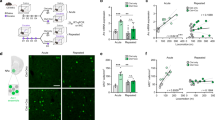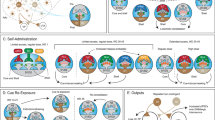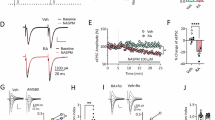Abstract
The intense associative memories that develop between cocaine-paired contexts and rewarding stimuli contribute to cocaine seeking and relapse. Previous studies have shown impairment in cocaine reward memories by manipulating a labile state induced by memory retrieval, but the mechanisms that underlie the destabilization of cocaine reward memory are unknown. In this study, using a Pavlovian cocaine-induced conditioned place preference (CPP) procedure in rats, we tested the contribution of ubiquitin-proteasome system-dependent protein degradation in destabilization of cocaine reward memory. First, we found that polyubiquitinated protein expression levels and polyubiquitinated N-ethylmaleimide-sensitive fusion (NSF) markedly increased 15 min after retrieval while NSF protein levels decreased 1 h after retrieval in the synaptosomal membrane fraction in the nucleus accumbens (NAc) core. We then found that infusion of the proteasome inhibitor lactacystin into the NAc core prevented the impairment of memory reconsolidation induced by the protein synthesis inhibitor anisomycin and reversed the effects of anisomycin on NSF and glutamate receptor 2 (GluR2) protein levels in the synaptosomal membrane fraction in the NAc core. We also found that lactacystin infusion into the NAc core but not into the shell immediately after extinction training sessions inhibited CPP extinction and reversed the extinction training-induced decrease in NSF and GluR2 in the synaptosomal membrane fraction in the NAc core. Finally, infusions of lactacystin by itself into the NAc core immediately after each training session or before the CPP retrieval test had no effect on the consolidation and retrieval of cocaine reward memory. These findings suggest that ubiquitin-proteasome system-dependent protein degradation is critical for retrieval-induced memory destabilization.
Similar content being viewed by others
Log in or create a free account to read this content
Gain free access to this article, as well as selected content from this journal and more on nature.com
or
References
Alberini CM (2011). The role of reconsolidation and the dynamic process of long-term memory formation and storage. Front Behav Neurosci 5: 12.
Anderson SM, Famous KR, Sadri-Vakili G, Kumaresan V, Schmidt HD, Bass CE et al. (2008). CaMKII: a biochemical bridge linking accumbens dopamine and glutamate systems in cocaine seeking. Nat Neurosci 11: 344–353.
Artinian J, McGauran AM, De Jaeger X, Mouledous L, Frances B, Roullet P (2008). Protein degradation, as with protein synthesis, is required during not only long-term spatial memory consolidation but also reconsolidation. Eur J Neurosci 27: 3009–3019.
Bardo MT, Rowlett JK, Harris MJ (1995). Conditioned place preference using opiate and stimulant drugs: a meta-analysis. Neurosci Biobehav Rev 19: 39–51.
Bekinschtein P, Katche C, Slipczuk L, Gonzalez C, Dorman G, Cammarota M et al. (2010). Persistence of long-term memory storage: new insights into its molecular signatures in the hippocampus and related structures. Neurotox Res 18: 377–385.
Ben Mamou C, Gamache K, Nader K (2006). NMDA receptors are critical for unleashing consolidated auditory fear memories. Nat Neurosci 9: 1237–1239.
Bernardi RE, Lattal KM, Berger SP (2007). Anisomycin disrupts a contextual memory following reactivation in a cocaine-induced locomotor activity paradigm. Behav Neurosci 121: 156–163.
Childress AR, McLellan AT, Ehrman R, O’Brien CP (1988). Classically conditioned responses in opioid and cocaine dependence: a role in relapse? NIDA Res Monogr 84: 25–43.
Conrad KL, Tseng KY, Uejima JL, Reimers JM, Heng LJ, Shaham Y et al. (2008). Formation of accumbens GluR2-lacking AMPA receptors mediates incubation of cocaine craving. Nature 454: 118–121.
Cornish JL, Kalivas PW (2000). Glutamate transmission in the nucleus accumbens mediates relapse in cocaine addiction. J Neurosci 20: RC89.
Dunah AW, Standaert DG (2001). Dopamine D1 receptor-dependent trafficking of striatal NMDA glutamate receptors to the postsynaptic membrane. J Neurosci 21: 5546–5558.
Duvarci S, Nader K (2004). Characterization of fear memory reconsolidation. J Neurosci 24: 9269–9275.
Ehlers MD (2003). Activity level controls postsynaptic composition and signaling via the ubiquitin-proteasome system. Nat Neurosci 6: 231–242.
Eisenberg M, Kobilo T, Berman DE, Dudai Y (2003). Stability of retrieved memory: inverse correlation with trace dominance. Science 301: 1102–1104.
Famous KR, Kumaresan V, Sadri-Vakili G, Schmidt HD, Mierke DF, Cha JH et al. (2008). Phosphorylation-dependent trafficking of GluR2-containing AMPA receptors in the nucleus accumbens plays a critical role in the reinstatement of cocaine seeking. J Neurosci 28: 11061–11070.
Fan HY, Cherng CG, Yang FY, Cheng LY, Tsai CJ, Lin LC et al. (2010). Systemic treatment with protein synthesis inhibitors attenuates the expression of cocaine memory. Behav Brain Res 208: 522–527.
Fioravante D, Liu RY, Byrne JH (2008). The ubiquitin-proteasome system is necessary for long-term synaptic depression in Aplysia. J Neurosci 28: 10245–10256.
Fonseca R, Vabulas RM, Hartl FU, Bonhoeffer T, Nagerl UV (2006). A balance of protein synthesis and proteasome-dependent degradation determines the maintenance of LTP. Neuron 52: 239–245.
Fuchs RA, Bell GH, Ramirez DR, Eaddy JL, Su ZI (2009). Basolateral amygdala involvement in memory reconsolidation processes that facilitate drug context-induced cocaine seeking. Eur J Neurosci 30: 889–900.
Ghasemzadeh MB, Vasudevan P, Mueller C, Seubert C, Mantsch JR (2009). Region specific alterations in glutamate receptor expression and subcellular distribution following extinction of cocaine self-administration. Brain Res 1267: 89–102.
He YY, Xue YX, Wang JS, Fang Q, Liu JF, Xue LF et al. (2011). PKMzeta maintains drug reward and aversion memory in the basolateral amygdala and extinction memory in the infralimbic cortex. Neuropsychopharmacology 36: 1972–1981.
Hegde AN, Goldberg AL, Schwartz JH (1993). Regulatory subunits of cAMP-dependent protein kinases are degraded after conjugation to ubiquitin: a molecular mechanism underlying long-term synaptic plasticity. Proc Natl Acad Sci USA 90: 7436–7440.
Hupbach A, Gomez R, Hardt O, Nadel L (2007). Reconsolidation of episodic memories: a subtle reminder triggers integration of new information. Learn Mem 14: 47–53.
Ito R, Robbins TW, Everitt BJ (2004). Differential control over cocaine-seeking behavior by nucleus accumbens core and shell. Nat Neurosci 7: 389–397.
Jarome TJ, Werner CT, Kwapis JL, Helmstetter FJ (2011). Activity dependent protein degradation is critical for the formation and stability of fear memory in the amygdala. PLoS ONE 6: e24349.
Jiang YH, Armstrong D, Albrecht U, Atkins CM, Noebels JL, Eichele G et al. (1998). Mutation of the Angelman ubiquitin ligase in mice causes increased cytoplasmic p53 and deficits of contextual learning and long-term potentiation. Neuron 21: 799–811.
Joels G, Lamprecht R (2010). Interaction between N-ethylmaleimide-sensitive factor and GluR2 is essential for fear memory formation in lateral amygdala. J Neurosci 30: 15981–15986.
Karpova A, Mikhaylova M, Thomas U, Knopfel T, Behnisch T (2006). Involvement of protein synthesis and degradation in long-term potentiation of Schaffer collateral CA1 synapses. J Neurosci 26: 4949–4955.
Lai CS, Franke TF, Gan WB (2012). Opposite effects of fear conditioning and extinction on dendritic spine remodelling. Nature 483: 87–91.
Lee JL (2008). Memory reconsolidation mediates the strengthening of memories by additional learning. Nat Neurosci 11: 1264–1266.
Lee JL, Milton AL, Everitt BJ (2006). Cue-induced cocaine seeking and relapse are reduced by disruption of drug memory reconsolidation. J Neurosci 26: 5881–5887.
Lee SH, Choi JH, Lee N, Lee HR, Kim JI, Yu NK et al. (2008). Synaptic protein degradation underlies destabilization of retrieved fear memory. Science 319: 1253–1256.
Lee SH, Liu L, Wang YT, Sheng M (2002). Clathrin adaptor AP2 and NSF interact with overlapping sites of GluR2 and play distinct roles in AMPA receptor trafficking and hippocampal LTD. Neuron 36: 661–674.
Li FQ, Xue YX, Wang JS, Fang Q, Li YQ, Zhu WL et al. (2010). Basolateral amygdala cdk5 activity mediates consolidation and reconsolidation of memories for cocaine cues. J Neurosci 30: 10351–10359.
Li YQ, Li FQ, Wang XY, Wu P, Zhao M, Xu CM et al. (2008). Central amygdala extracellular signal-regulated kinase signaling pathway is critical to incubation of opiate craving. J Neurosci 28: 13248–13257.
Li YQ, Xue YX, He YY, Li FQ, Xue LF, Xu CM et al. (2011). Inhibition of PKMzeta in nucleus accumbens core abolishes long-term drug reward memory. J Neurosci 31: 5436–5446.
Lopez-Salon M, Alonso M, Vianna MR, Viola H, Mello e Souza T, Izquierdo I et al. (2001). The ubiquitin-proteasome cascade is required for mammalian long-term memory formation. Eur J Neurosci 14: 1820–1826.
Lu L, Grimm JW, Hope BT, Shaham Y (2004). Incubation of cocaine craving after withdrawal: a review of preclinical data. Neuropharmacology 47 (Suppl 1): 214–226.
Lu L, Hope BT, Dempsey J, Liu SY, Bossert JM, Shaham Y (2005). Central amygdala ERK signaling pathway is critical to incubation of cocaine craving. Nat Neurosci 8: 212–219.
Lu L, Wang X, Wu P, Xu C, Zhao M, Morales M et al. (2009). Role of ventral tegmental area glial cell line-derived neurotrophic factor in incubation of cocaine craving. Biol Psychiatry 66: 137–145.
Mao LM, Wang W, Chu XP, Zhang GC, Liu XY, Yang YJ et al. (2009). Stability of surface NMDA receptors controls synaptic and behavioral adaptations to amphetamine. Nat Neurosci 12: 602–610.
Meil WM, See RE (1996). Conditioned cued recovery of responding following prolonged withdrawal from self-administered cocaine in rats: an animal model of relapse. Behav Pharmacol 7: 754–763.
Meredith GE, Agolia R, Arts MP, Groenewegen HJ, Zahm DS (1992). Morphological differences between projection neurons of the core and shell in the nucleus accumbens of the rat. Neuroscience 50: 149–162.
Meredith GE, Baldo BA, Andrezjewski ME, Kelley AE (2008). The structural basis for mapping behavior onto the ventral striatum and its subdivisions. Brain Struct Funct 213: 17–27.
Merlo E, Romano A (2007). Long-term memory consolidation depends on proteasome activity in the crab Chasmagnathus. Neuroscience 147: 46–52.
Milekic MH, Brown SD, Castellini C, Alberini CM (2006). Persistent disruption of an established morphine conditioned place preference. J Neurosci 26: 3010–3020.
Miller CA, Marshall JF (2005). Molecular substrates for retrieval and reconsolidation of cocaine-associated contextual memory. Neuron 47: 873–884.
Milton AL, Everitt BJ (2010). The psychological and neurochemical mechanisms of drug memory reconsolidation: implications for the treatment of addiction. Eur J Neurosci 31: 2308–2319.
Myers KM, Davis M (2002). Behavioral and neural analysis of extinction. Neuron 36: 567–584.
Nader K, Hardt O (2009). A single standard for memory: the case for reconsolidation. Nat Rev Neurosci 10: 224–234.
Nader K, Schafe GE, Le Doux JE (2000). Fear memories require protein synthesis in the amygdala for reconsolidation after retrieval. Nature 406: 722–726.
Nishimune A, Isaac JT, Molnar E, Noel J, Nash SR, Tagaya M et al. (1998). NSF binding to GluR2 regulates synaptic transmission. Neuron 21: 87–97.
Noel J, Ralph GS, Pickard L, Williams J, Molnar E, Uney JB et al. (1999). Surface expression of AMPA receptors in hippocampal neurons is regulated by an NSF-dependent mechanism. Neuron 23: 365–376.
O'Brien CP, Childress AR, McLellan AT, Ehrman R (1992). Classical conditioning in drug-dependent humans. Ann NY Acad Sci 654: 400–415.
Osten P, Srivastava S, Inman GJ, Vilim FS, Khatri L, Lee LM et al. (1998). The AMPA receptor GluR2 C terminus can mediate a reversible, ATP-dependent interaction with NSF and alpha- and beta-SNAPs. Neuron 21: 99–110.
Pastalkova E, Serrano P, Pinkhasova D, Wallace E, Fenton AA, Sacktor TC (2006). Storage of spatial information by the maintenance mechanism of LTP. Science 313: 1141–1144.
Paxinos G, Watson C (2005) The Rat Brain in Stereotaxic Coordinates 5th edn. Elsevier Academic Press: Amsterdam.
Pedreira ME, Maldonado H (2003). Protein synthesis subserves reconsolidation or extinction depending on reminder duration. Neuron 38: 863–869.
Quirk GJ, Mueller D (2008). Neural mechanisms of extinction learning and retrieval. Neuropsychopharmacology 33: 56–72.
Ramirez DR, Bell GH, Lasseter HC, Xie X, Traina SA, Fuchs RA (2009). Dorsal hippocampal regulation of memory reconsolidation processes that facilitate drug context-induced cocaine-seeking behavior in rats. Eur J Neurosci 30: 901–912.
Rao-Ruiz P, Rotaru DC, van der Loo RJ, Mansvelder HD, Stiedl O, Smit AB et al. (2011). Retrieval-specific endocytosis of GluA2-AMPARs underlies adaptive reconsolidation of contextual fear. Nat Neurosci 14: 1302–1308.
Rosenblum K, Meiri N, Dudai Y (1993). Taste memory: the role of protein synthesis in gustatory cortex. Behav Neural Biol 59: 49–56.
Schiller D, Monfils MH, Raio CM, Johnson DC, Ledoux JE, Phelps EA (2010). Preventing the return of fear in humans using reconsolidation update mechanisms. Nature 463: 49–53.
Serrano P, Friedman EL, Kenney J, Taubenfeld SM, Zimmerman JM, Hanna J et al. (2008). PKMzeta maintains spatial, instrumental, and classically conditioned long-term memories. PLoS Biol 6: 2698–2706.
Shema R, Sacktor TC, Dudai Y (2007). Rapid erasure of long-term memory associations in the cortex by an inhibitor of PKM zeta. Science 317: 951–953.
Song I, Kamboj S, Xia J, Dong H, Liao D, Huganir RL (1998). Interaction of the N-ethylmaleimide-sensitive factor with AMPA receptors. Neuron 21: 393–400.
Sutton MA, Schmidt EF, Choi KH, Schad CA, Whisler K, Simmons D et al. (2003). Extinction-induced upregulation in AMPA receptors reduces cocaine-seeking behaviour. Nature 421: 70–75.
Suzuki A, Josselyn SA, Frankland PW, Masushige S, Silva AJ, Kida S (2004). Memory reconsolidation and extinction have distinct temporal and biochemical signatures. J Neurosci 24: 4787–4795.
Theberge FR, Milton AL, Belin D, Lee JL, Everitt BJ (2010). The basolateral amygdala and nucleus accumbens core mediate dissociable aspects of drug memory reconsolidation. Learn Mem 17: 444–453.
Tronson NC, Taylor JR (2007). Molecular mechanisms of memory reconsolidation. Nat Rev Neurosci 8: 262–275.
Whiteheart SW, Schraw T, Matveeva EA (2001). N-ethylmaleimide sensitive factor (NSF) structure and function. Int Rev Cytol 207: 71–112.
Xu CM, Wang J, Wu P, Zhu WL, Li QQ, Xue YX et al. (2009). Glycogen synthase kinase 3beta in the nucleus accumbens core mediates cocaine-induced behavioral sensitization. J Neurochem 111: 1357–1368.
Yao Y, Kelly MT, Sajikumar S, Serrano P, Tian D, Bergold PJ et al. (2008). PKM zeta maintains late long-term potentiation by N-ethylmaleimide-sensitive factor/GluR2-dependent trafficking of postsynaptic AMPA receptors. J Neurosci 28: 7820–7827.
Yi JJ, Ehlers MD (2005). Ubiquitin and protein turnover in synapse function. Neuron 47: 629–632.
Yu LL, Wang XY, Zhao M, Liu Y, Li YQ, Li FQ et al. (2009). Effects of cannabinoid CB1 receptor antagonist rimonabant in consolidation and reconsolidation of methamphetamine reward memory in mice. Psychopharmacology (Berl) 204: 203–211.
Acknowledgements
This work was supported in part by the Natural Science Foundation of China (nos. 31230033, 91132716, and 31070958). We thank Dr Yavin Shaham for his helpful comments on the manuscript.
Author information
Authors and Affiliations
Corresponding author
Ethics declarations
Competing interests
The authors declare no conflict of interest.
Rights and permissions
About this article
Cite this article
Ren, ZY., Liu, MM., Xue, YX. et al. A Critical Role for Protein Degradation in the Nucleus Accumbens Core in Cocaine Reward Memory. Neuropsychopharmacol 38, 778–790 (2013). https://doi.org/10.1038/npp.2012.243
Received:
Revised:
Accepted:
Published:
Issue date:
DOI: https://doi.org/10.1038/npp.2012.243
Keywords
This article is cited by
-
Neuroadaptations and TGF-β signaling: emerging role in models of neuropsychiatric disorders
Molecular Psychiatry (2022)
-
Ube2b-dependent degradation of DNMT3a relieves a transcriptional brake on opiate-induced synaptic and behavioral plasticity
Molecular Psychiatry (2021)
-
Simvastatin Blocks Reinstatement of Cocaine-induced Conditioned Place Preference in Male Mice with Brain Lipidome Remodeling
Neuroscience Bulletin (2021)
-
Molecular and circuit mechanisms regulating cocaine memory
Cellular and Molecular Life Sciences (2020)
-
Genome-wide transcriptional profiling of central amygdala and orbitofrontal cortex during incubation of methamphetamine craving
Neuropsychopharmacology (2018)



